Nitrate and Sensor Fouling | How Does EXO NitraLED Perform During Storms?
As most everyone who works with water quality instrumentation in freshwater environments has experienced, storms are one of the predominant influencers that lead to fouling. During storm events, a wide variety of things that are not normally found in baseflow waters are introduced from the watershed into the system – sediment, oil, salt, trash, and more – and can impact the quality of the data.
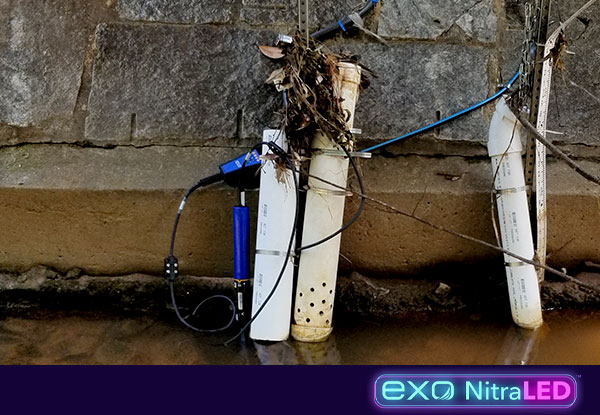
While a lot of technologies do not adapt well to rapid changes in water velocity caused by significant stormflow, there are numerous examples of YSI sondes being even partially buried by debris but still collecting data.
However, for all instruments, heavier particles and sediments can collect on sensor faces and cause erratic or falsely elevated appearance in the dataset. It is when we see this incorrect data that we need to make a site visit!
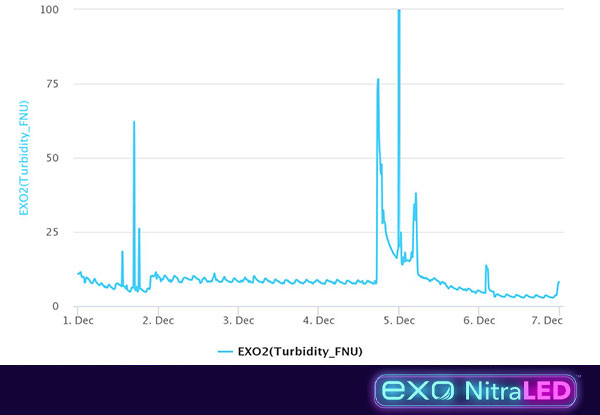
After the storm event on December 1, the data became erratic and then remained elevated when compared to normal baseflow values.
Storm events are one of the reasons that robust anti-fouling approaches are so important. These anti-fouling methods could be an air compressor, squeegee type wiper, UV lamp (for marine type biofouling), or a tough bristled wiper like that available for the EXO Sonde. Not all anti-fouling methods yield equal results; some are definitely more helpful than others.
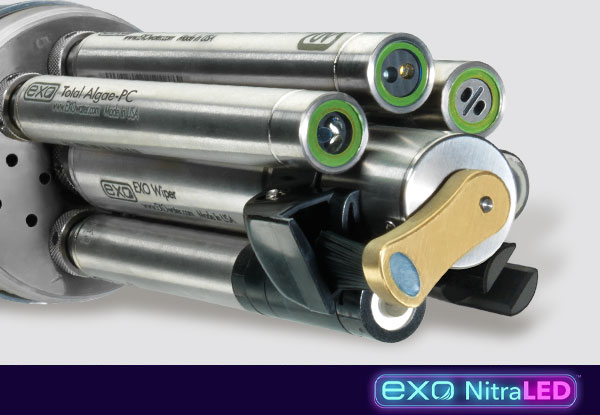
EXO Wiper Brush
There are two different brushes available for the EXO Sonde – one for use with a standard sensor payload and one for use with a sensor payload that includes the EXO NitraLED UV Nitrate Sensor. Both brushes are comprised of tough bristles that will remove any fouling but will not scratch the lens faces of any of the sensors.
Importantly, the wipers themselves are made of materials that are resistant to fouling, making them more effective than some other wipers in the industry. In the set of images below, the EXO Sonde is shown with the standard wiper brush attached in the center port with a suite of water quality sensors around it. Note how much sediment accumulation the sides of the sonde and sensors have, but also pay particular attention to the fact that the sensor faces (where the measurements actually take place) are perfectly clean.
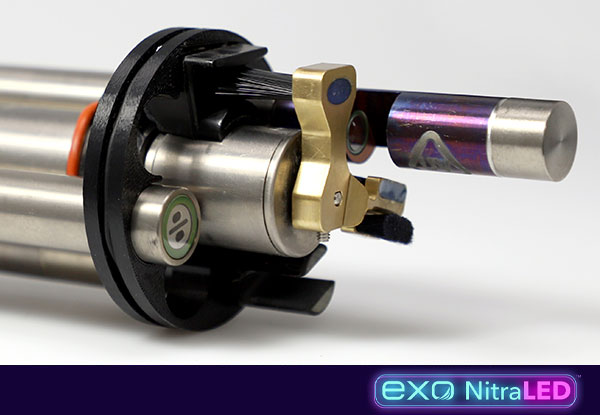
EXO NitraLED Wiper Brush
Before we discuss the cleaning power of the EXO NitraLED Wiper Brush, it is important to know why the design of the brush had to change. The NitraLED sensor is absorbance-based and actually has an optical path rather than just a sensor face, so we had to modify our industry-leading wiper to work with this sensor. The new brush has a second arm dedicated to keeping the NitraLED sensor clean and the main arm is still the same Wiper Brush that has been trusted to keep sensor faces clean for years.
A question that many scientists have had recently is whether or not the new NitraLED wiper brush will protect against fouling in the same way. The answer to that question is simply, YES. Our test site at the University of Georgia experiences a wide range of fouling sources from sediment, to mud, to pollen, to trash and other debris. When we deployed the EXO NitraLED sensor at this site, we wanted to not only test the sensor functionality but also the efficacy of the wiper. We were not disappointed.
Note that the images below are showing one of our first design concepts in action – with a beta version wiper and a beta version alignment ring. Both the wiper and the alignment ring have since been optimized into the version that we offer today.
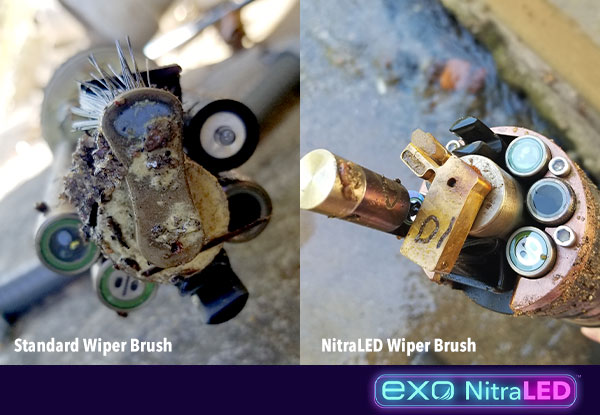
Based on the outside of the sensors, we certainly would have expected the sensor data to show significant fouling. However, we can see in the graph below that fouling did not appear to impact sensor readings at all after these storm events.
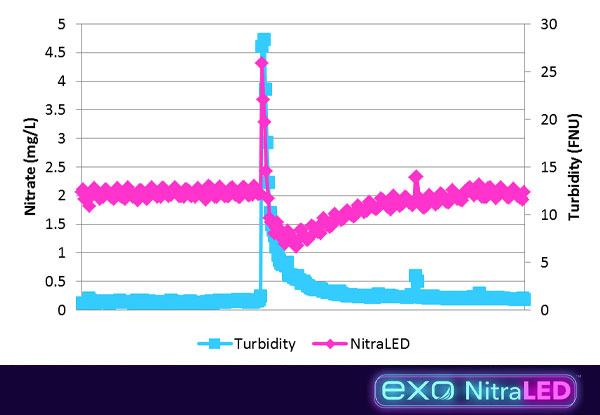
As can be seen from the turbidity and nitrate data in the graph, the data recovered to an appropriate baseflow value and did not have any erratic spikes, thanks to the NitraLED Central Wiper Brush. The new wiper brush was effective at removing any type of fouling material from the sensor and prevented a technician from visiting the site after this storm event.
Additional Experience
Our current NitraLED users have experienced the same anti-fouling benefits from the NitraLED Wiper Brush. In the dataset below, the NitraLED sensor is compared to a nitrate technology that costs up to three times as much as a NitraLED sensor. The anti-fouling mechanism on the competing sensor is still a brush but it does not have the strength to clean away tough sediment accumulation.
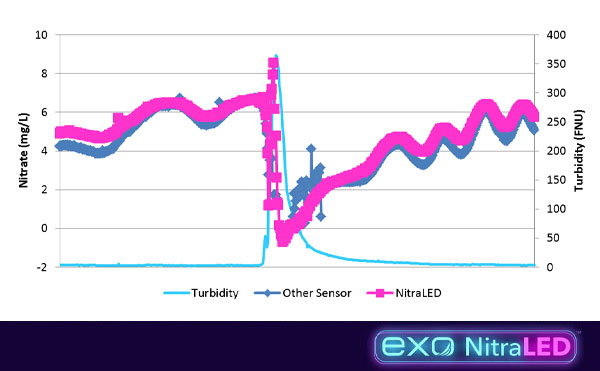
One thing that is interesting to point out in this dataset is that the NitraLED sensor did in fact record negative values. Of course, we cannot have negative nitrate but there is an explanation for these values – exceedingly high turbidity levels!
The NitraLED sensor can work in a variety of combinations of nitrate, natural organic matter, and turbidity, but as any of these variables are increased, so too does the scatter and absorption of light transmitted from the LED’s. The photodiode can only measure up to a certain absorbance level and if this level is exceeded, the resulting measurement of nitrate will be inaccurate.
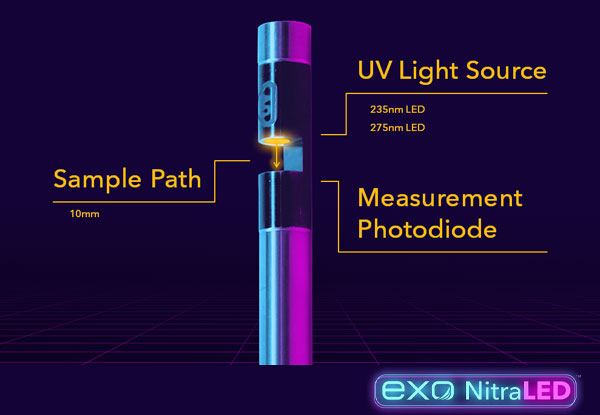
All optical nitrate monitoring devices have this absorbance headroom issue and some manufacturers try to counter the effect with smaller path lengths. The path length on the NitraLED sensor is set at 10 mm so that the central wiper can pass through and keep the lenses clean of debris.
YSI recommends that the sensor be deployed in conditions with turbidity lower than 200FNU but again, if the NOM effect is minimal, then the sensor can be deployed in conditions greater than 200FNU and still deliver good data. For additional information on the NitraLED sensor mechanics, please see our technical note on how the sensor corrects for turbidity and NOM.
The most important thing to note here is that the NitraLED sensor did not require a specific field visit to clean off the sensor, saving the customer time and money. The competing sensor, however, fouled and was recording erratic data because the wiper was not strong enough to remove the sediment that had accumulated. It required a field visit to be cleaned and reset in place.
As seen in the data, the NitraLED sensor returned to baseflow values after the storm event as well; again proving the effectiveness of the NitraLED Wiper Brush. The customer who monitors this site was very excited to see that the NitraLED sensor and EXO wiper brush combination would allow them to minimize the number of trips to the site because they would not have to visit after every storm event like they have to with the other sensor.
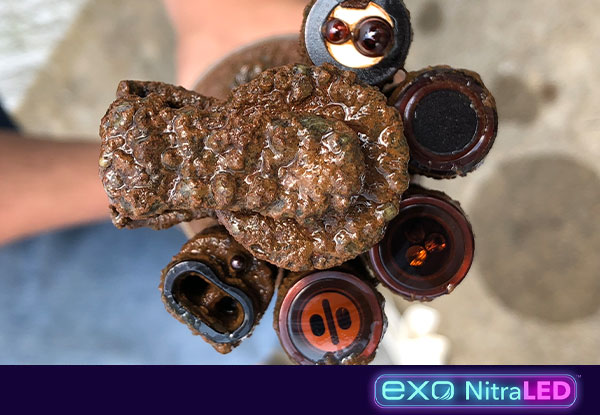
Fouling will always be a threat in natural environments but with some planning surrounding equipment choice and site setup, trips to the field can be minimized saving time and money. If you have any questions about stormwater deployments and anti-fouling, please feel free to leave a comment below!
